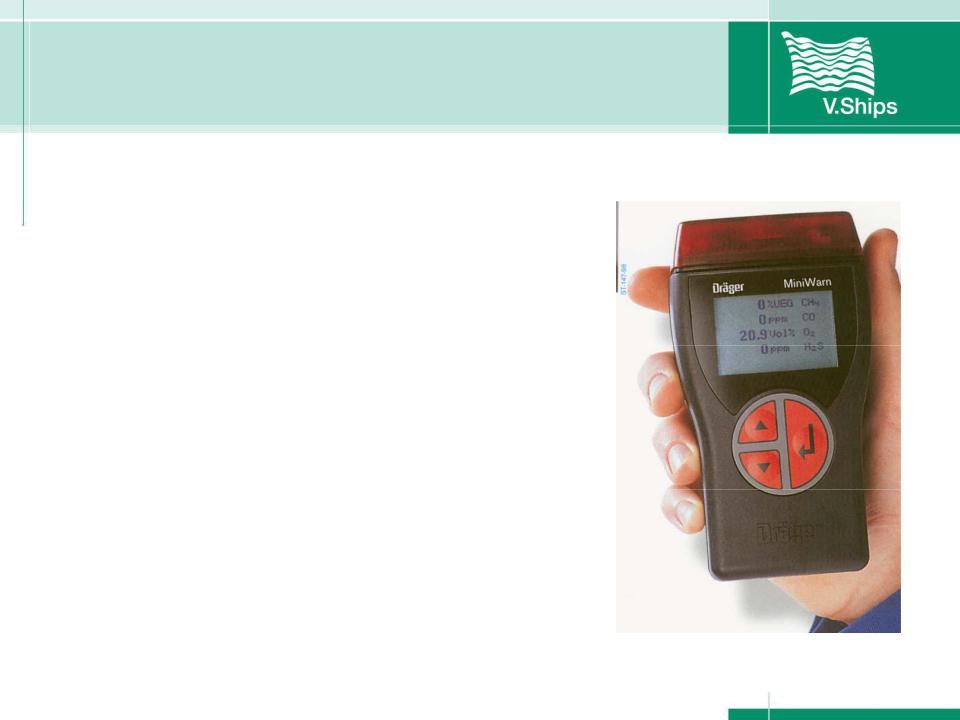
Chemical Tankers / Day 5 / Day 5 Topic 2 Gas & Safety Equipment
.pdf
Gas Detection Equipment
Personnel must fully understand the purpose and limitations of vapour detection equipment, whether fixed or portable
The maintenance record of all gas detection equipment is to be completed on each occasion that the instrument is tested or checked

Gas Detection Equipment
The importance of careful calibration cannot be over emphasised as the gas detection or analysing equipment will only give accurate readings if calibration is carried out strictly in compliance with the manufacturers instructions and using correct calibration gases

Portable Gas Detectors
It is essential that any test equipment used is:
Suitable for test required
Sufficiently accurate for the test required
Of an approved type
Correctly maintained
Frequently checked against standard samples

Portable Gas Detectors
In the next few slides we will look at the various types of portable gas detection equipment in further detail

Portable Gas Detectors
Measurement of hydrocarbon concentrations
The measurement of hydrocarbon concentrations on tankers falls into two categories
1.The measurement of hydrocarbon gas in air at concentrations below the lower flammable limit (LFL).
2.The measurement of hydrocarbon gas as a percentage by volume (% Volume) of the total atmosphere being measured.

Portable Gas Detectors
1.The measurement of hydrocarbon gas in air at concentrations below the lower flammable limit (LFL)
To detect the presence of flammable vapours (the risk of an explosion)
To detect the presence of hydrocarbon vapours which may be harmful to personnel

Portable Gas Detectors
Readings are expressed as a percentage of LFL
(% LFL or LEL)
Instrument used to measure % LFL is a Catalytic filament combustible gas (CFCG) indicator.
Usually referred to as a Explosimeter or Flammable Gas monitor
Should NOT be used to measure hydrocarbon gas in an inert atmosphere.

Portable Gas Detectors
Examples of this type of instrument, capable of measuring up to the LFL are:
MSA Explosimeter types 2, 2E, 5 (Type 4 is not suitable for tankers)
MSA Combustible Gas Indicator models L, LV, V, P
Draeger Trialarm (also measures H2S and O2)
Riken Keiki GP226/236
Portagas GM002
Portagas 1, 2, 3, and 4 GM 010 - 013 (also measure O2 or toxic gas)
Portagas Mini 3, 4 (also measure O2 and toxic gas)
Gastech GX 7, GX 82, GX 86 (also measure O2 and/or toxic gas)
Toka Seiki P 507, P 508

Oxygen analysers
Portable oxygen analysers are used to determine whether the atmosphere inside an enclosed space (i.e.. a cargo tank) may be considered fully inerted or safe for entry.
The following are the most common type of oxygen analysers used
Paramagnetic sensors
Electrochemical sensors

Portable Gas Detectors
As with all analysers they should be carefully maintained and tested strictly in accordance with manufacturers instructions.
It is essential that a periodic check is made of batteries, zero setting, and calibration.
The use of water retaining filters is essential particularly with the paramagnetic type as the presence of water can damage the measuring cell.
